
Water flossers are an alternative to string floss
Instead of relying on traditional string floss, water flossers can be a viable substitute. Research indicates that incorporating a water flosser in conjunction with regular tooth brushing can decrease bleeding gums by 37%, a recommendation also supported by the European Federation of Periodontology.
Our in-house dentist Dr. Gemma Wheeler notes that interdental brushes are the most effective method of cleaning, but she does recommend water flossers for some people:
"A water flosser doesn’t replace interdental brushes, which are the most effective interdental cleaning method. My recommendation to patients is to find a cleaning method that works for them, and there is certainly a place for water flossers. The most effective type of interdental cleaning is the one that you will actually do."
In this post we recommend some reliable water flossers based on vigorous hands-on testing and advice from Dr. Wheeler.
What to look for in a water flosser
In this post we offer recommendations for both corded (countertop) and cordless water flossers. If you have space (approx 6 x 6 inches) for one in your bathroom, we recommend going for countertop over cordless — we explain this in more detail in this section.
Both types of flosser come with similar features, not all of which are necessary. From our hands-on testing, the most essential features of a water flosser are:
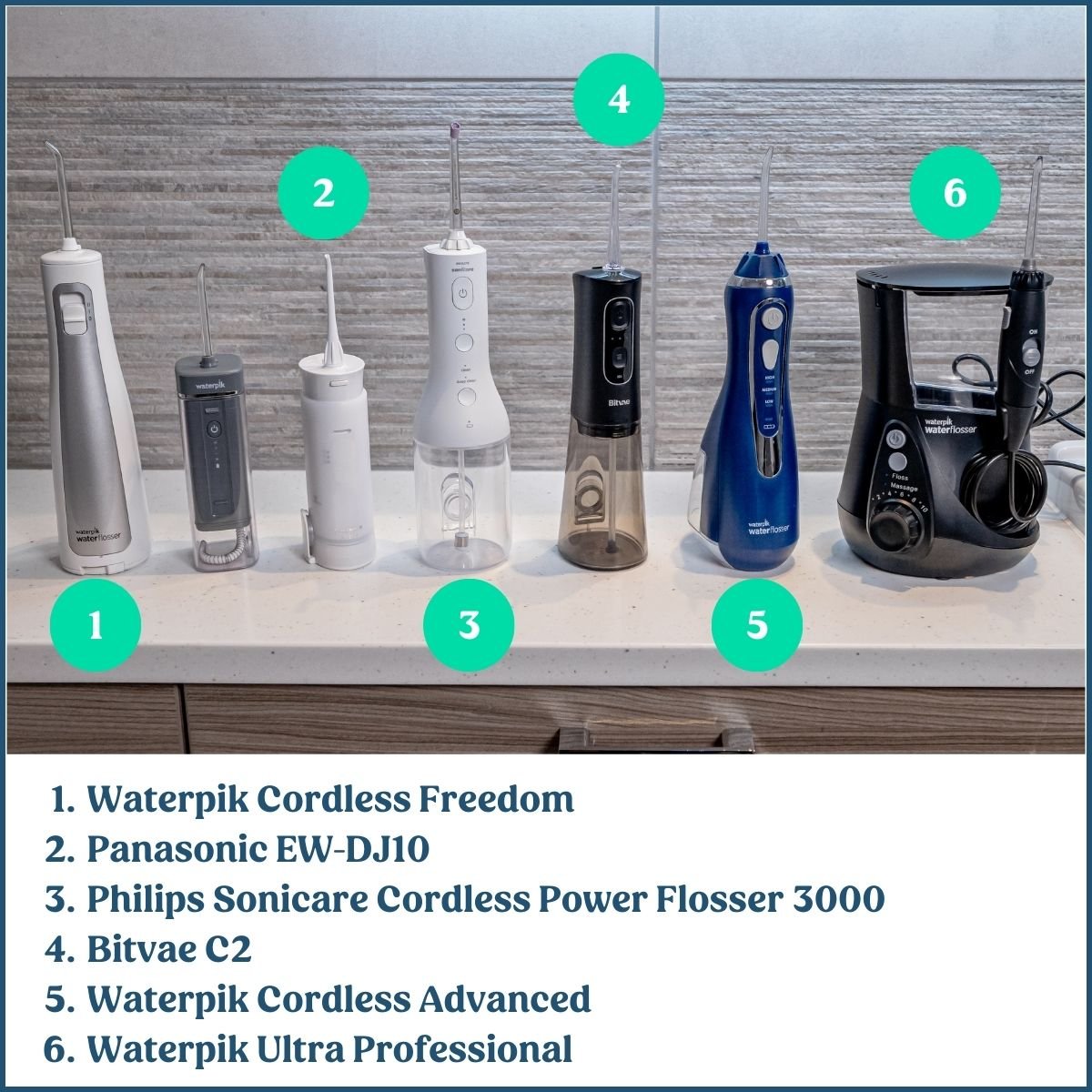
Best countertop (corded)
Waterpik Ultra Professional WP-660

Why it's the best countertop flosser:
The Ultra Professional WP-660 has all of the essential features we look for in a water flosser. It is a suitable option whether you are taking proactive steps to clean interdentally, have periodontal disease or if you're recovering from oral surgery. We also rate it as the best water flosser for braces (more on that below).
It is not portable like our best cordless choice below, the WP-560, but the slim handle is easy to hold and move around the mouth. The WP-560 is great, but, the smaller handle on the Ultra Professional gives the feeling of greater control. In-hand comfort is really quite important. In our testing, we found it easy to control the water flow from the handle, and the water pressure was easy to adjust with the rotating dial.
More info, pros & cons
The WP-660 is fairly compact with hose storage to keep things neat, although there is no place to store any excess power cable. It actually has a smaller profile than you might imagine and although it's bulky, it doesn’t feel as dominant on a countertop as you might expect
An inherent benefit of a countertop option is that it has a larger water tank. The 600ml capacity means that you can floss for longer or get multiple flossing sessions from one single fill. There are 10 different pressure settings on the Ultra Professional. This is more than you need, but it does give a very finite level of control, which we like. Each setting varies by 10PSI.
Read our Waterpik Ultra Professional Review.
What we like |
Worth noting |
|---|---|

80+ second flossing time |
No place to stow excess power cable |

Easy to rotate the nozzle |
It’s a more expensive option |

10 pressure settings |
|

Water control button on handle |
|

Hose storage |
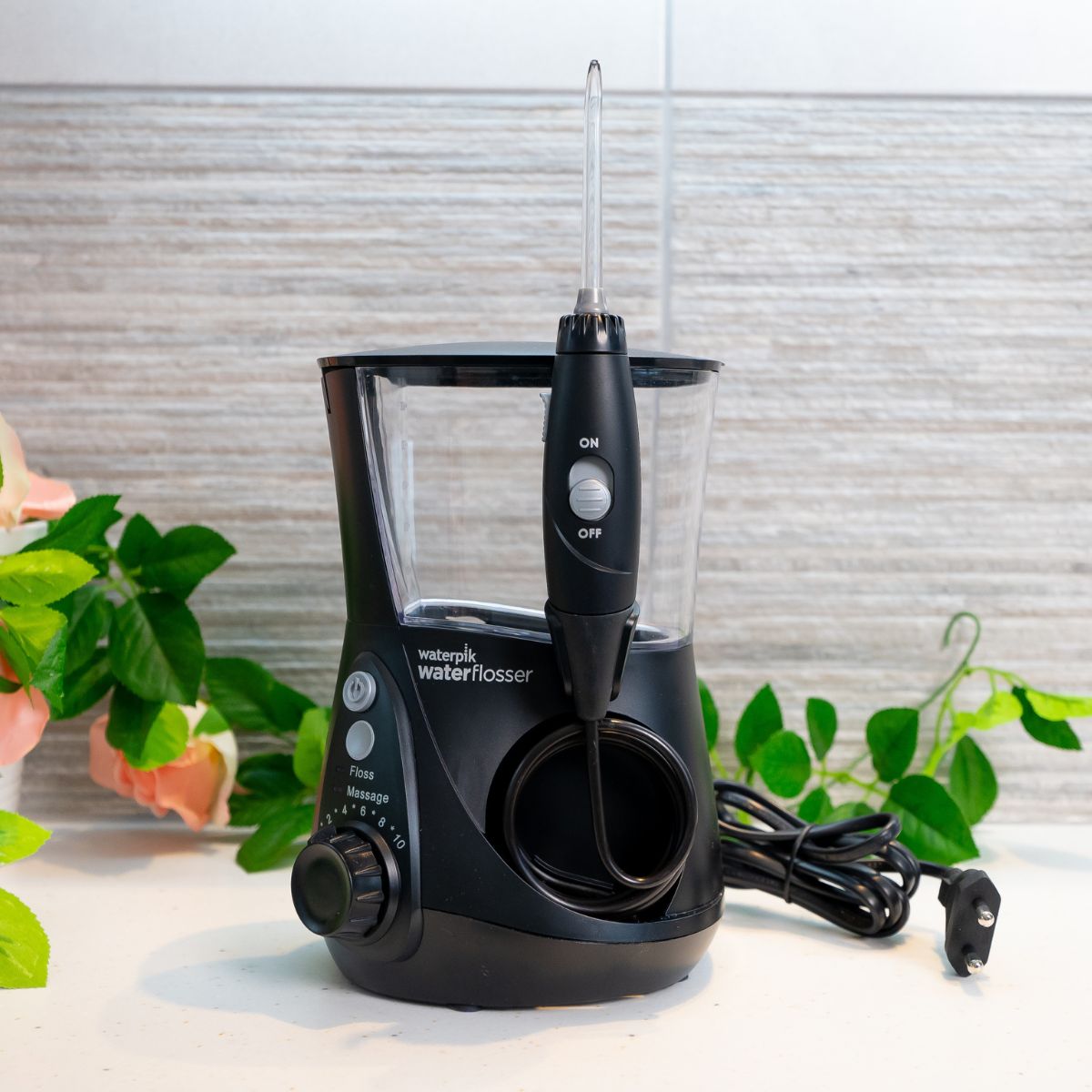
Best cordless
Ordo Hydro Sonic

Why it's the best cordless:
I like how grippy and comfortable the Ordo Hydro Sonic is to hold. It doesn’t feel as heavy or bulky as I’d expected given its water tank is so large.
The 260ml tank and 3 pressure settings gave me anywhere between 50-60 seconds of usage time, which is sufficient as I’ve mastered my technique. You may need to refill to get the clean you desire. I can’t fault the cleaning results, which are comparable to those of leading brands.
I did find the nozzle very stiff to rotate, which is a problem I’ve encountered with a lot of cordless water flossers. This isn’t a problem for me as I’m now used to rotating my hand rather than the nozzle to get the coverage of the mouth that I want. It’s not a deal breaker by any means, but it’s something to be aware of when you first start using the flosser.
More info, pros & cons
I like the on-demand button. It makes it incredibly easy to start and stop the water flow, which gives greater control and creates a little less mess than other flossers I’ve tested. The highest pressure setting is very powerful and I can see how it could be toointense for sensitive teeth and gums. Those with periodontal disease are best off considering a flosser with lower power settings, such as the Cordless Advanced from Waterpik.
It’s a shame no travel case is provided, but the ability to stow 2 nozzles inside the flosser is brilliant as is the travel lock button.
I found the Hydro Sonic easy to wipe clean and dry off after use. It is exceptionally good value and, all things considered, caters to most users.
Watch our Ordo Hydro Sonic Review.
What we like |
Worth noting |
|---|---|

Textured grip |
Difficult to rotate the nozzle |

3 pressure settings |
No travel pouch |

On-demand button |
Tilt to drain tank fully |

USB type c charging |
|

45+ second flossing time |
|

Travel lock button |
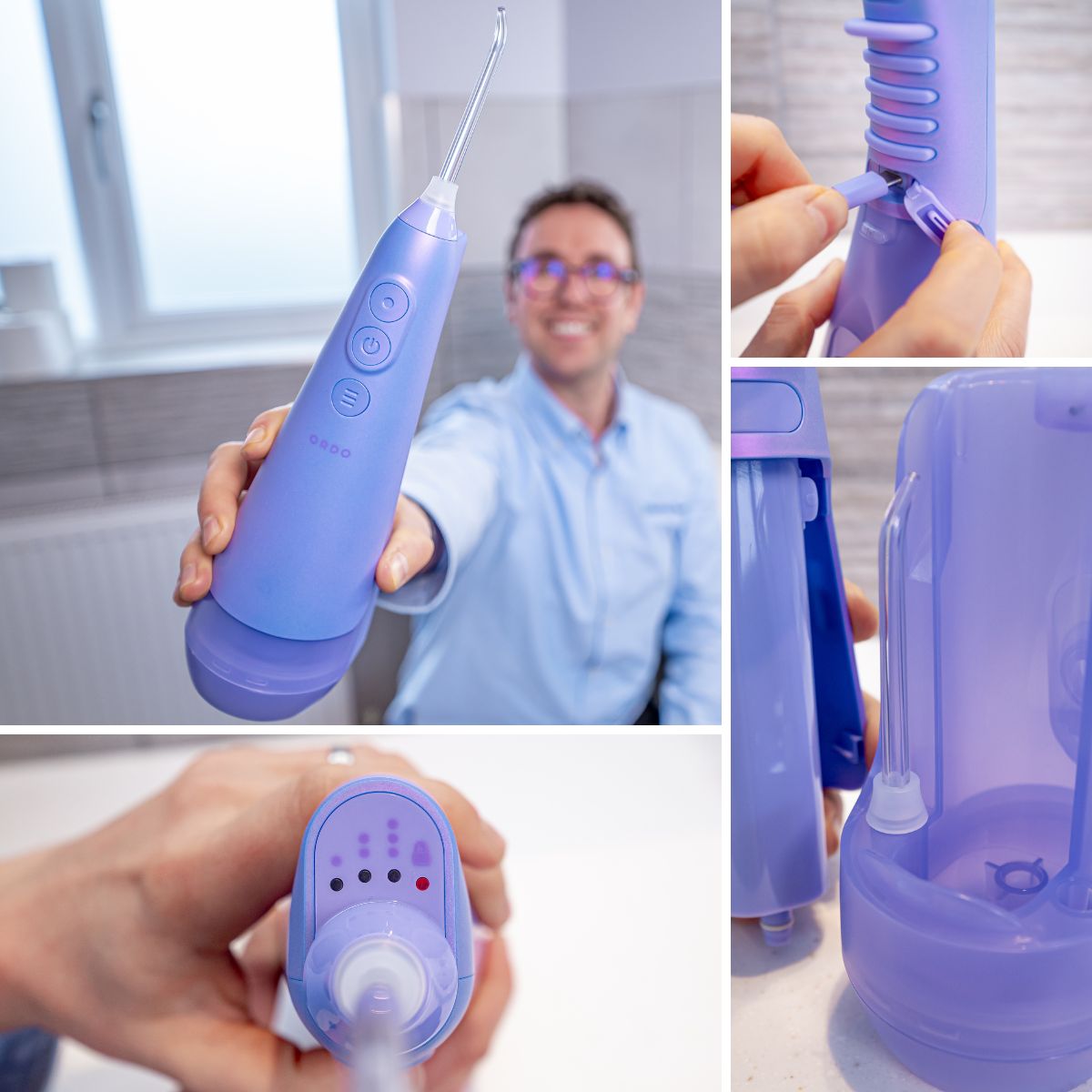
Best budget
Bitvae C2

Why we chose it:
The Bitvae C2 has all the features we recommend of a cordless water flosser and comes with enough nozzles for several years of use, all for a very fair price.
Bitvae flossers don't have the clinical backing of the likes of Waterpik or Philips Sonicare, but I can confirm from my own testing that performance is comparable. I'd struggle to tell the difference if I were blindfolded.
I did find that the nozzle wasn't as easy to hold and rotate with one hand compared to the Waterpik Cordless Advanced, but I wouldn't regard that as a big enough inconvenience to be a deal-breaker, especially if I was shopping on a budget.
The overall feel isn't quite as premium as other irrigators, but it's not a stark difference
More info, pros and cons
It's a shame Bitvae opted for a USB to barrel pin style charging cable, unlike the much more convenient and easily replaced USB type-c cable used by the Sonicare Cordless Power Flosser 3000. However, it is less bulky than the USB charging cable of the Cordless Advanced.
The lack of a travel case is a shame, but not a reason to overlook the C2.
Although I've had no failures during my testing, an overriding concern is the durability and reliability of the Bitvae C2. As a newer brand they don't have the proven track record like big name competitors and supplying only a 1 year warranty doesn't help their case.
Watch our Bitvae C2 irrigator review.
What we like |
Worth noting |
|---|---|

Good value for money |
1 year warranty |

Plenty of nozzles included |
Barrel pin charging connector isn’t as convenient as USB |

Large tank |
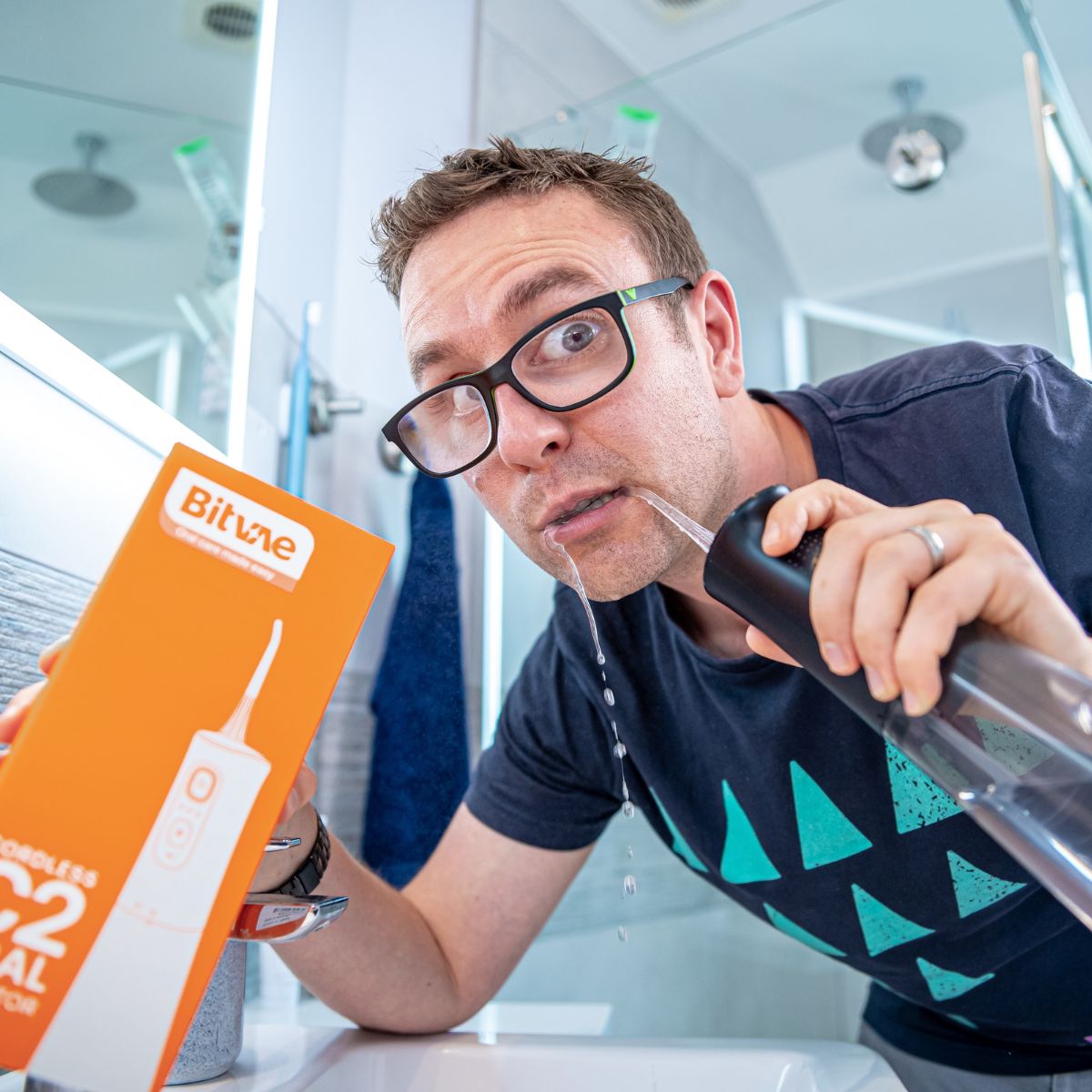
Video overview

Other flossers we considered
Only a select few of the water flossers we test actually make it into this best list.
And yet, we can’t say that any of the water flossers we have tested are really bad.
We have been most disappointed by the Waterpik Sonic-Fusion. Admittedly this is a hybrid product, rather than a standalone water flosser. It combines an electric toothbrush and water flosser to create a flossing toothbrush.
Unfortunately, the Fusion isn’t great at either job. It is noisy and cumbersome to use. You don’t get to enjoy all the benefits of an electric toothbrush and water flosser. You are better off sticking with separate items. A regular electric toothbrush and one of Waterpik’s other countertop water flossers.
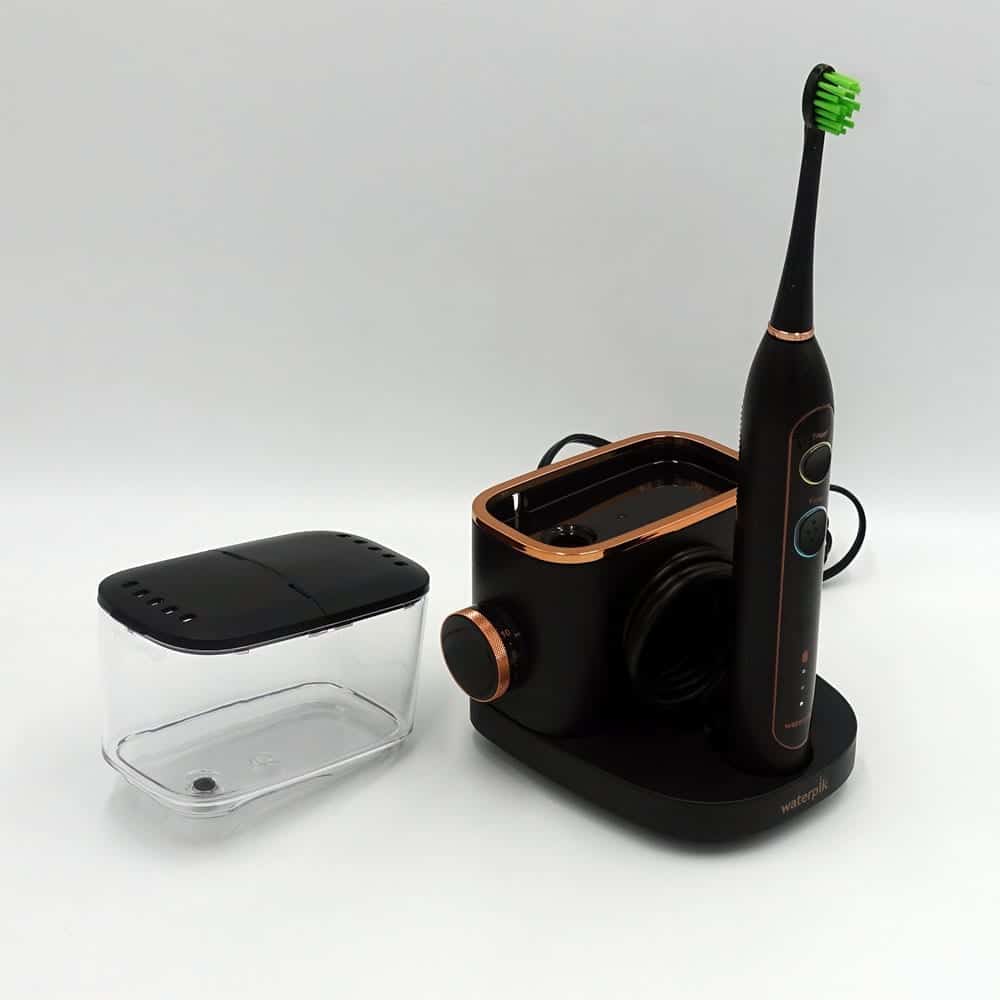
The Waterpik WF-06 and WF-05 are 2 countertop models that have ‘whitening’ capabilities. The WF-05 Whitening Professional is the premium model.
Both allow you to add whitening tablets into the handle of the flosser. As the water passes through, it dissolves the tablet. It results in a mildly abrasive solution being pushed against the tooth surface. The idea is that it will remove light surface stains from your teeth.
The tablets contain glycerine which helps to lift the stains off the tooth surface. Silica, also contained in the tablets, is an abrasive ingredient which also helps remove stains. Both are effective stain removers and are commonly found in professional polishing pastes.
In theory, it works. Waterpik has done its own research and found it to be effective at removing stains.
In practice, people are often disappointed. It is an expensive solution that doesn’t deliver the tooth whitening results most would expect from Waterpik calling it a “whitening” water flosser. It is only ever going to remove extrinsic staining. It won’t change the natural colour of the teeth like professional bleaching.
Keep reading about other flossers we've tested...
Oral-B is a major player in the oral care space. It has produced water flossers in the past, the Oxyjet being the most well-known.
But it has been quite some time since it has competed properly within this space. Recently it has attempted to change this with its new Aquacare range.
Given its experience and might within the industry we expected better.
Both the Aquacare 4 and the Aquacare 6 Pro-Expert have a 45 second flossing time. Both have at least 2 pressure settings, 2 weeks of battery life and a water resistant design.
Both have rotating nozzles, are comfortable to hold and come with a 2 year warranty.
But, neither feel the best quality. The retaining clip for the water tank on the Aquacare 4 broke off in our testing.
The nozzles do rotate, but not all that easily.
The different pressure settings and modes are made more complicated than they need to be.
Both come with bulky charging stands that are less than ideal for travel.
And both are more expensive than they should when accounting for these shortcomings.
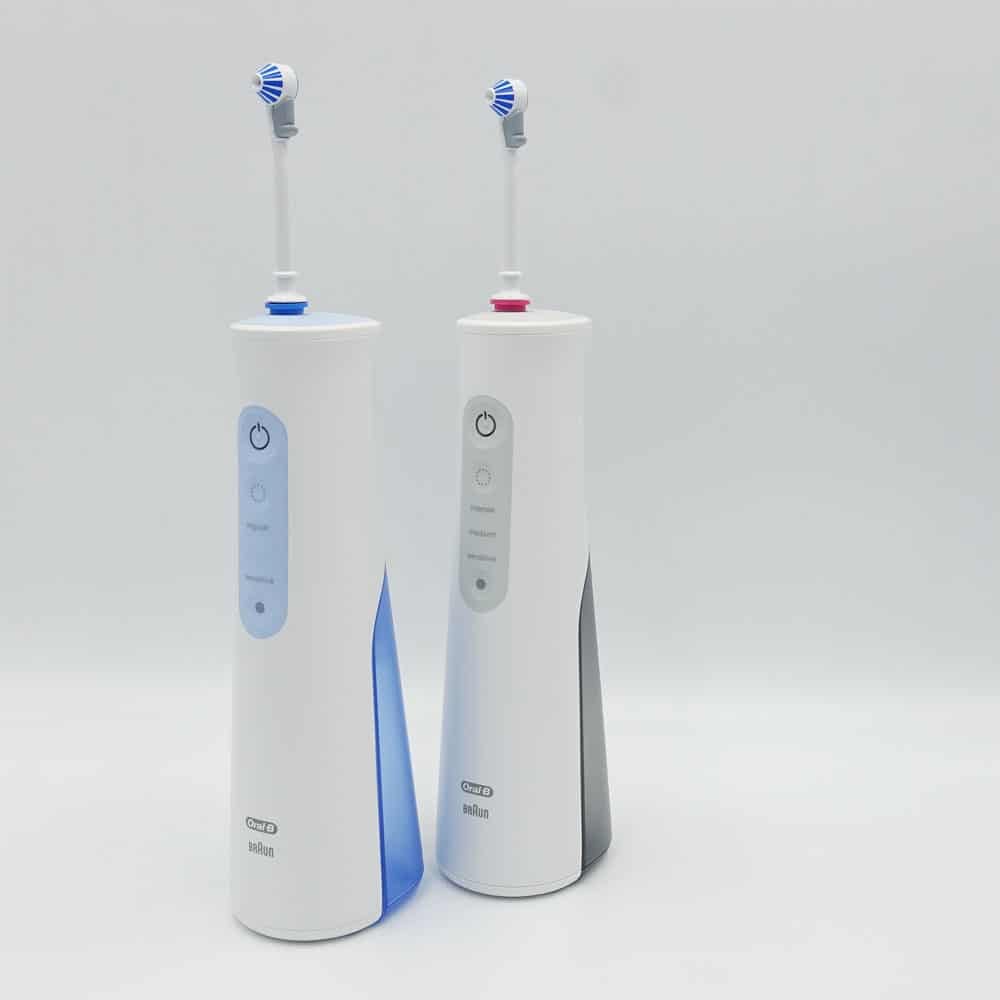
Waterpik makes excellent water flossers. They are our top pick for a countertop unit and for a long time have also been a top choice for a cordless model. However, the much-loved Cordless Advanced has been ousted by the Hydro Sonic from Ordo, which represents much better value for money.
That said, you could do a lot worse than picking the Advanced, it is a great alternative if you have deeper pockets and want the market-leading brand.
The Cordless 3000 from Sonicare is another solid choice. I’ve achieved longer usage times from it because the reservoir is bigger. Add in the X-shaped water jet that covers a larger surface area with each pass of the teeth and gums.
Neither the Sonicare or Ordo have the effortless nozzle rotation of the Waterpik, but it’s not a reason alone to pay the price premium of the latter.
However, it isn’t perfect; the Waterpik's nozzles rotate easier and replacement nozzles are more affordable.
Fairywill has built a reputation for offering cheap alternatives to the major brands.
However, reports have emerged about Fairywill products breaking sooner than they should, which is one of the risks of going for cheaper products from less well-known brands.
They also don't come with the refinements of their more expensive counterparts.
For example, with the Fairywill 5020A and 5020E you have to connect a power cable into the flossers. The Cordless Advanced and Cordless Select WF-10 have magnetic chargers.
In fact, the Cordless Select has a magnetic USB charging cable. This is super convenient and great for travellers.
Yet, despite this benefit, it loses favour because of the cramped grip. You don’t get the same in hand comfort as the vast majority of other models. We found it one of the most awkward models to use.
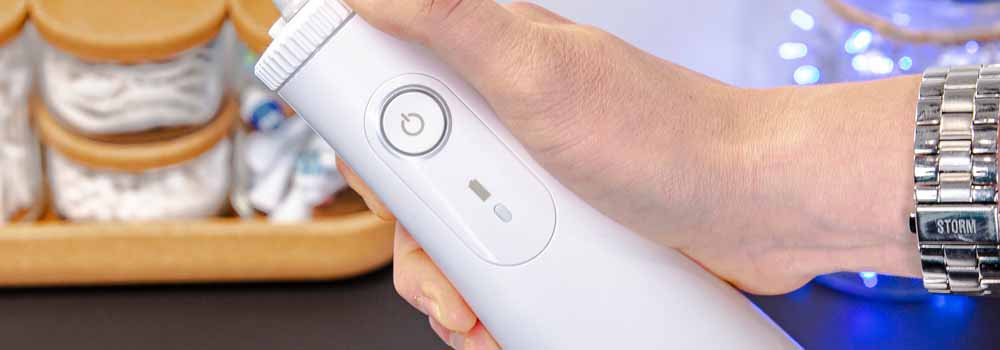
You don’t have to worry quite so much about in hand comfort with the likes of the Waterpik Nano, Ultra or Ultra Plus. These are countertop units. They have slim handles, which the fingers and thumbs easily hold onto.
The Nano, Ultra and Ultra Plus are all good options. But, there is little to differentiate between them. When you consider their features and price, our preference is the Ultra Professional.
None of the Waterpik units will ever be as cheap as the east Asian brands — Truewell, Hangsun, Atmoko and Nicwell to name a few — nor will you get as many accessories in the box.
But if you do want a cheaper option from Waterpik, the WF-03 Cordless Freedom is a good option.
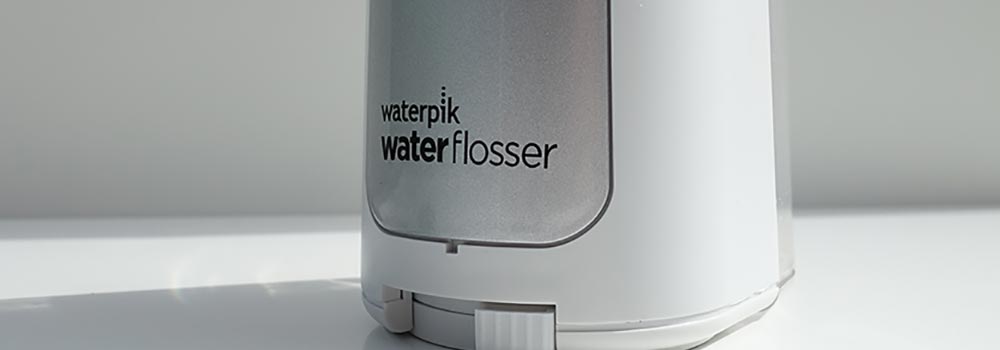
The compromise here is the small water tank. It is just 150ml. This means less flossing time per fill of the tank. It also has removable AA batteries rather than a built-in rechargeable one. But, in its favour, you do have the option of the different types of interchangeable nozzles. You don’t with most other cheap models.
All flossers, irrespective of brand, have their pros and cons. For our main recommendations, we have chosen products that are comfortable to use and come with the features that we regard as essential. Comfort is important when it comes to interdental cleaning — the more comfortable a product is, the more likely you are to build a good flossing habit.
Our budget pick isn’t quite as comfortable to use, but it still has the features you need and it’s a good option if you don’t want to pay the price tag of the high end models.
Buyer's guide: useful pre-purchase advice

With the help of our in-house dentist Dr. Gemma Wheeler, we’ve added useful notes and tips from our research and testing. In the sections below, we include the most relevant and important information about shopping for a water flosser. If you’ve got any questions or would like further advice, please leave a comment below.
Who should use a water flosser?
Overall, water flossers are not the most effective method for plaque removal. But they still show benefits for gum health.
They are a good option for someone who has tried and failed to use interdental brushes.
Our in-house dentist Dr. Gemma Wheeler says:
"I would recommend a water flosser to certain people:
- Those who have limited hand mobility and so struggle with interdental brushes.
- People with large gaps where a brush doesn’t fit but food gets trapped.
- Those who won’t use floss and brushes due to a gag reflex, negative experience, or who can’t get the technique right.
- Someone with braces, to help clean around the brackets.
I also say anyone who wants to try them can add them to an existing routine e.g. interdental brushes.
Even with the evidence available, I know that the most effective type of interdental cleaning is the one that you will actually do. I want to support people to make flossing a habit."
Cordless vs corded (countertop) water flossers
If you have space (approx 6 x 6 inches) for one in your bathroom, we recommend going for a countertop over a cordless water flosser. There is no evidence to suggest one is better than the other — scientific studies confirm the effectiveness of both types. In our own hands-on testing, we have found them to be as effective as each other.
We’ve found countertop models slightly more comfortable to use. They also have larger water reservoirs, meaning they have longer cleaning times and need to be refilled less often. They often come with extra features, such as extra pressure settings or a built-in timer.
That being said, a cordless water flosser is still a perfectly good option if you don’t have space for a countertop model, or if you travel a lot. Countertop units need a power outlet. They need to be plugged in for them to work. You are therefore more restricted on where you place them. Cordless units are wire-free. This makes them more portable and convenient, particularly if you don’t have a socket in your bathroom.
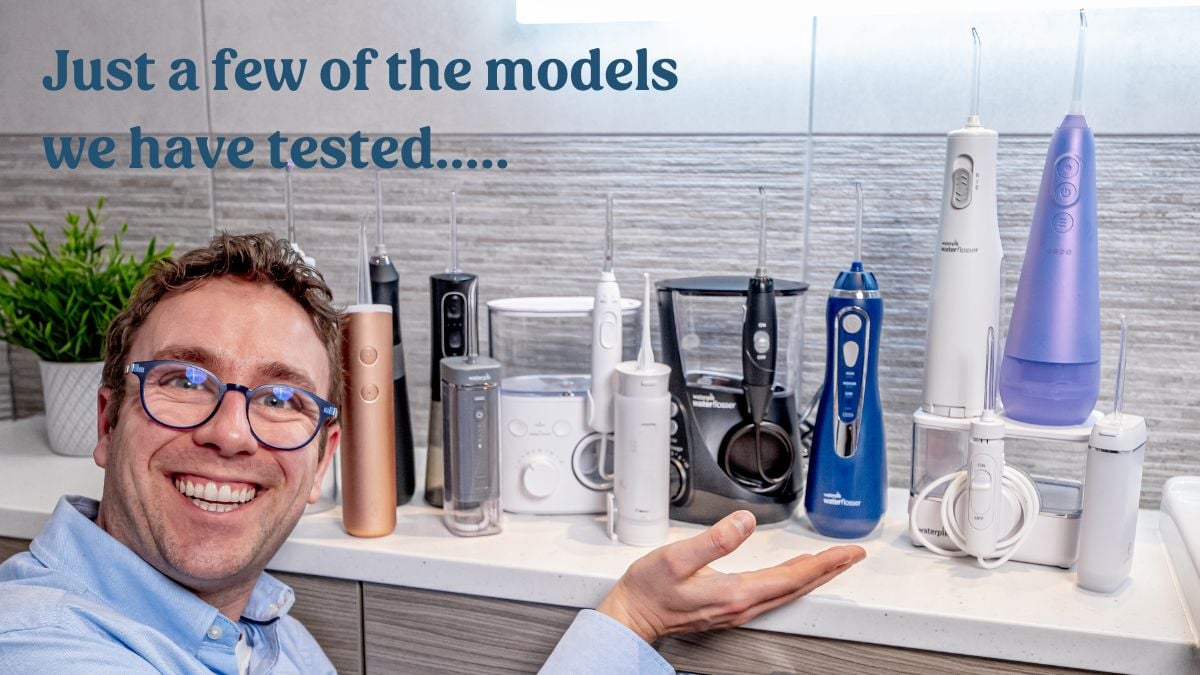
Examples of how much space countertop flossers take up
One of the drawbacks to countertop water flossers is that they are larger.
Each model is different, but you generally need an area 6 x 6 inches or 15 x 15cm on your countertop to accommodate the footprint of the water flosser.
You then want to have about 10-12 inches (25-30cm) space above this free for the unit to stand upright.
Each corded unit has a power cable that is around 3-4ft (90-120cm) in length. The hose from the handle tends to be of a similar length too.
A maximum distance from the power socket and the sink is approximately 2 meters. Any more than this and you will likely struggle.
If you are short of countertop space, one option is to store the flosser elsewhere and get it out as and when you need it. Many people place it in a bathroom cabinet. This overcomes the space issue, but regular use can become more challenging as it takes more effort and time to get it setup, and there isn’t the visual reminder from it sitting in plain sight.
Here is a table comparing the sizes of some of the most popular water flossers.
| Model | Width | Depth | Height |
|---|---|---|---|
| Waterpik Ultra Professional | 4.70 inches (11.94 cm) | 3.80 inches (9.65 cm) | 10.35 inches (26.29 cm) |
| Waterpik Ultra Plus | 5.60 inches (14.22 cm) | 5.30 inches (13.46 cm) | 9.90 inches (25.15 cm) |
| Waterpik Sidekick | 5.70 inches (14.48 cm) | 3.90 inches (9.91 cm) | 4.84 inches (2.29 cm) |
| Waterpik Nano | 5.40 inches (13.72 cm) | 4.40 inches (11.18 cm) | 6.80 inches (17.27 cm) |
| Hydro Floss | 8.27 inches (21cm) | 3.93 inches (10cm) | 4.92 inches (12.5cm) |
A bit more on why having different pressure settings is useful
You might not need to switch between them all the time, but having the choice is valuable. Whilst countertop water flossers can have as many as 10 settings, 2 or 3 is common for cordless models. You want at least a low and a high setting. As the names imply, the pressure varies between these. Low is more gentle and high more intense.
Pressure is measured in Pounds Per Square Inch (PSI) or Bar. Typically the pressure ranges from 10 to 100 PSI, although some models reach as much as 160 PSI. Low pressure tends to be around 30-45 PSI and high 60-80 PSI, subject to model.
The extra power can blast away more debris, but sheer force is not essential and may feel uncomfortable to some people. Lower pressure with the correct technique is equally as effective. There is no evidence to support using higher power over a lower power. A low setting is ideal for inflamed, sensitive and bleeding gums. If you have healthy teeth and gums, the higher setting can be used.
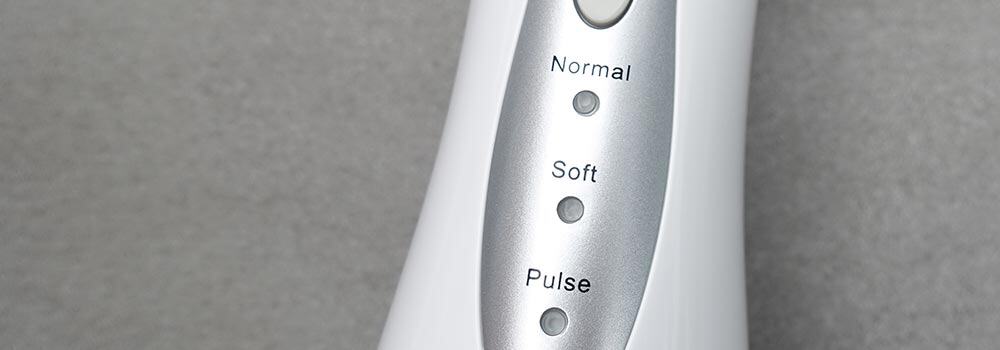
How a water flosser can be helpful for brace wearers
Water flossers can easily remove food and other debris from around the brackets on the teeth. All of our recommendations above are a good choice for brace wearers. Many brands also have specialised tips for braces to achieve even better results.
Using a water flosser to remove food and plaque will reduce the risk of decay on these tooth surfaces. They also have some positive effects on gum health, as proven in independent research.
Dr. Gemma Wheeler regards them as a good option for people who have braces, but also recommends using interdental brushes:
"If you have braces I would recommend a water flosser in addition to brushing and interdental brushes to get between the teeth.
Interdental brushes are still recommended for interdental cleaning with braces because the overwhelming evidence shows that interdental brushes are the most effective method for cleaning interdentally."
In the section below Dr. Wheeler goes into more detail about the various options for flossing with braces and how you can use a water flosser to maintain good oral health whilst undergoing orthodontic treatment.
Find out more about using a water flosser with braces...
Water flossing vs string flossing with braces
There is agreement that having braces slightly increases your risk of things like tooth decay and gum disease. That is because the brackets stuck to your teeth retain more bacteria, compared to if they weren’t there. Some dentists fall back on the recommendation of string floss for cleaning between the teeth when you have braces.
There are very few studies that directly compare floss and water flossers for brace wearers. Those that do, such as Jolkovsky or that by Pithon et al have mixed results. They seem to agree that both floss and water flossers both remove more bacteria than tooth brushing alone. But they can’t agree that one is much better than the other. String flossing is very technique sensitive. In non-brace wearers it is normally found to be the least effective technique for cleaning between the teeth. Wearing braces makes using floss an even bigger challenge.
The wires get in the way of pulling floss down between the teeth. A flossing tool can help you use string floss. For example, a floss threader allows you to get the floss above the wire and between the teeth. A platypus tool is used like a flossette - it holds the floss tight and the thinner plastic arms mean you can slide it under the wire no problem. Using a water flosser can be easier.
Also, the physical contact of string floss can be more beneficial than water. But when cleaning around a brace, using string floss can be very time consuming and awkward. Water flossers enable you to clean all around the bracket as well as between the teeth. They dislodge food particles. And it is believed that the water flow acts to massage the gums and reduce bleeding from the gums.
Overall, interdental brushes are the most effective option for cleaning. But when it comes to floss vs water flossers, there is no definitive right or wrong answer — it's about finding a cleaning method that works for you. There is certainly a place for water flossers. Ideally, though, you want to be combining the use of a water flosser with interdental brushes.
How a water flosser can help with braces
The design of a dental brace means you have more surface area for bacteria and food to stick to. Food particles get caught in brackets and wires. Getting food particles and dental plaque trapped around your braces can increase your risk of dental disease.
The increased surface area and nooks and crannies of the fittings give more opportunity for plaque to build up on the teeth. It also makes the plaque more difficult to remove.
Failing to clean around these can result in:
- Staining of the teeth
- Decalcification (white spots) on the tooth surface
- tooth decay
- Gingivitis (gum disease)
- Bad breath
Good plaque removal is vital to prevent the onset of gum disease
To remove plaque, you should brush around all parts of your brace and all of the surfaces of your teeth. There is a mixed consensus about when to brush your teeth if you have braces. Ideally, you should brush each time you have eaten. Generally, the advice is to brush straight away. This is especially true if you are wearing removable braces as it means you can put them in as soon as possible. Sometimes, the advice is to leave it about 30 minutes after every meal or snack, before you brush. This would be the recommendation if you have eaten or drunk something particularly acidic. This includes fruits and fizzy drinks.
A manual brush works well if used correctly, but our advice is to invest in an electric toothbrush. A study by the American Journal of Orthodontics and Dentofacial Orthopaedics found that electric toothbrushes promote better cleaning habits. If you find toothbrushing difficult, switching to an electric toothbrush has an even better effect.
You need to floss in addition to brushing
Even the best toothbrushes and brushing technique won’t remove all the plaque around a brace. You need to use other flossing tools in addition to brushing. The wires and brackets restrict the movement of floss in between the teeth and up into the gum line. This makes flossing with braces awkward.
You do not need a water flosser as a brace wearer, but you do need to clean interdentally. Water flossers make it more convenient to clean these surfaces and reach the gumline. The water and the pressure at which it hits the teeth gets into the smallest of gaps. It also disrupts the bacteria chains that cause gum disease. The evidence doesn’t support water flossers removing plaque. But yet, it still has a positive effect on the gums.
An orthodontic flossing tip can be useful
There are a variety of interchangeable tips available for water flossers. The orthodontic tip can be very useful for braces. It combines a traditional jet tip with bristles to wash and sweep away the debris. The manual action of the bristles gives an extra dimension to the clean. They can help dislodge and disrupt debris and bacteria.
Not all water flossers come with them, but they can usually be purchased separately. Our two main recommendations above — the WP-660 and WP-560, do come with an orthodontic tip supplied in the box. Nearly all of Waterpik's models are compatible with the orthodontic tip, so Waterpik is a good choice in that respect.
The clinical evidence for and against water flossers
Water flossers are one of the less common forms of interdental cleaning. They are safe, with little ability to cause damage to the gums. Going by the studies that have been completed, it seems that water flossers do not fully remove plaque. Despite this, they can still have a positive effect on the gums, as we explain below.
Waterpik publishes its own clinical research
Waterpik has listed a large amount of clinical research on its website. Some people could perceive this as biased. But it is worth noting that it is independently scrutinised to be published in peer-reviewed journals. This means that you can discount any obvious problems with their data. However, do consider that they are unlikely to promote data that doesn’t support their hypotheses (read: advertising claims). Many of the articles are not available in full online, only the Waterpik summary or the paper abstracts.
Highlights from their research are (the link will lead you to the journal article, not the Waterpik page):
- Using a water flosser in addition to toothbrushing reduces bleeding gums and plaque levels. Lyle et al. compared bleeding scores and plaque levels in two groups: those using only an electric toothbrush; those using an electric toothbrush + water flosser. They found that the group who used the water flosser had decreased levels of bleeding gums. The plaque levels were also lower in those using the water flossers. Although these results were of less statistical significance.
- Waterpiks reduce gingival inflammation more than flossing does. Barnes et al. 2005 study found a Waterpik to be more effective than string floss in reducing gingival bleeding. This study compared manual toothbrush + floss to manual toothbrush + water flosser and sonic toothbrush + water flosser. They miss out a key comparison group: sonic toothbrush + flossing. This makes the evidence somewhat skewed in favour of the water flosser. Much of the benefit of switching to a powered brush is presented as being the water flosser, but there is no way to compare.
- Water flossers are effective and safe for implants. Kotsakis et al. showed that water flossers are as effective as interdental brushes and more effective than chlorhexidine mouthwash. They reduce the amount of bacteria on implants, without damaging the implant surface.
Independent reviews and papers support most of these claims
Independent reviews by Ng and Lim as well as Worthington et al showed that water flossers do not reduce plaque levels. This is also shown in Waterpik’s own study in 2011. Despite ineffective plaque removal, water flossers do reduce inflammation of the gums. They reduce bleeding from the gums, an indicator for active gum disease.
Water flossers might not reduce levels of plaque, but it is thought they do disrupt forming plaque from above and below the gum level. The theory is that this changes the structure of the plaque layer. If the plaque structure is altered, it may cause less inflammation in the gums. But at present, this is only a theory.
The water flossers also flush out food debris. This 2015 review by Sälzer et al also supports water flossers for improving gingival health versus no interdental cleaning aid. The European Federation of Periodontology (EFP) also recommends water flossers for interdental cleaning in their evidence based guidelines.
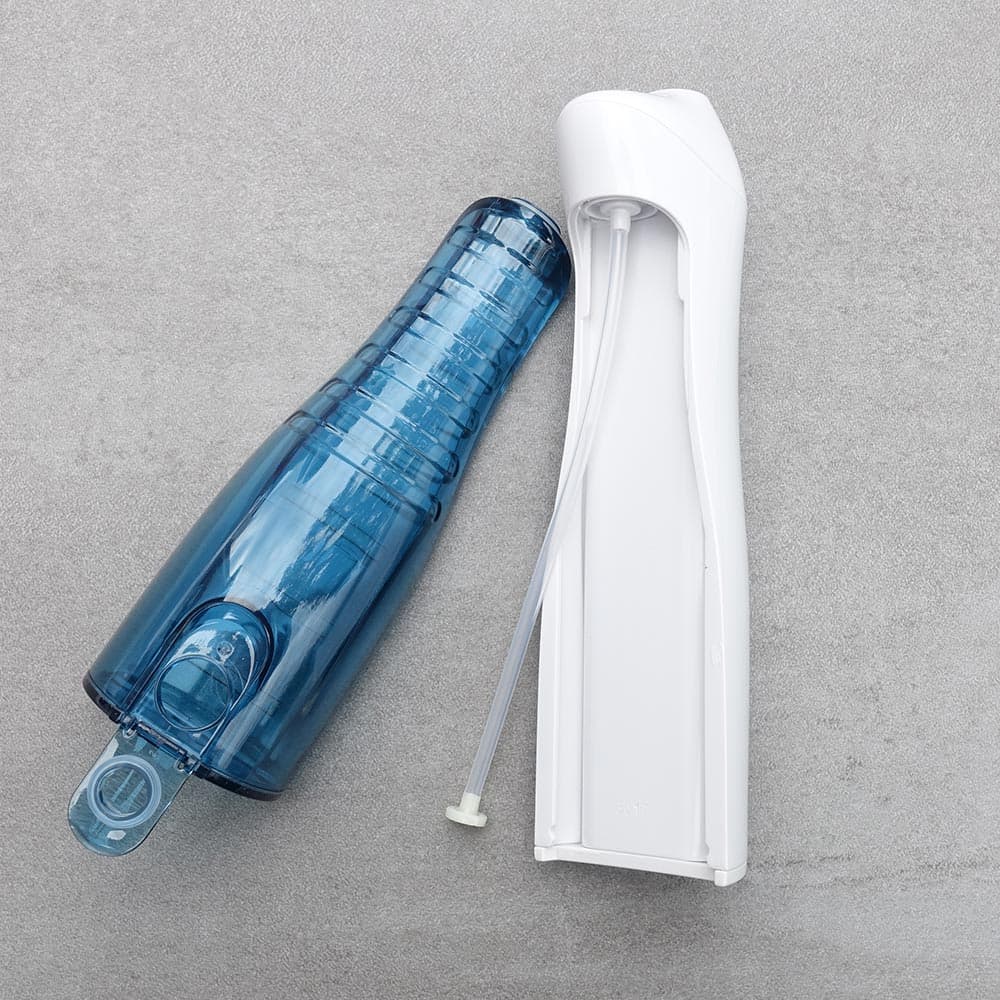
Find out more in our water flosser reviews
We've gathered the advice and recommendations above by thoroughly testing and comparing many water flossers. We usually create a written review, video review, or both for each brush.
You can see our written reviews below and watch our video reviews and comparisons on our YouTube channel.
- Waterpik Cordless Advanced vs Philips Sonicare Cordless Power Flosser 3000
- Philips Sonicare Cordless Power Flosser 3000 review
- Oral-B Aquacare 6 Pro-Expert Water Flosser review
- Oral-B Aquacare 4 vs 6 Pro-Expert
- Waterpik Professional Whitening Water Flosser review
- Oral-B Aquacare 4 Water Flosser review
- Waterpik Cordless Select review
- Panasonic EW1511 review
- Waterpik Cordless Advanced review
- Waterpik WP-660UK Ultra Professional review





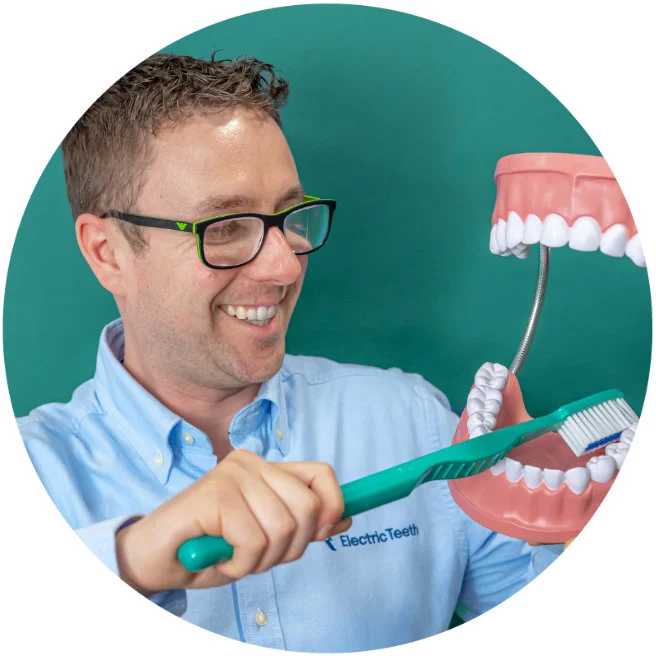

Waterpik cordless is really good, however the battery is just a hassle. I have to charge it constantly and it takes ages to fully charge the battery, so at the end of the day is not as cordless as it should be, unfortunately I’m returning my unit due to its poor battery. So I wouldn’t recommend this product at all just for that.
I was thinking to buy Panasonic EW1511 Rechargeable Dental Oral Irrigator with Ultrasonic Technology. It has lithium battery that charges in just 1 hour and is more durable and not a NiMH battery from the last decade like the Waterpik one.
Any advice regarding this!?
Hi Juan. Sorry to hear you are not satisfied with the Waterpik.
The Panasonic EW1511 is a good comparable alternative. We have reviewed it here on our US website. Sourcing nozzles is challenging though.
That’s great! I’m going to watch it right now!
The other option is the Phillips Sonicare 3000 HX3806/33
Which one is better Phillips or Panasonic ?
Thanks !
I have published a review on the Sonicare Cordless Power Flosser just a few days ago.
I can't really say 1 is 'better' than the other. They are just a bit different. Sonicare probably takes the edge. Nozzles are easier to source & it has USB type-c charging.
I just purchased a waterpik cordless, I do not find the water as powerful as I expected after seeing videos on it. It doesn't really clean the plaque off as much as I had expected. It is ok but not amazing. Does anyone know if there is one with more powerful jet of water, even if a different make or model. Also I am searching for a comparison with the watts or power but cannot find one
Hi Emma. Is it the cordless advanced that you purchased? There are a few different models with cordless in the name. Generally, the power they offer is very similar.
You don't need a really powerful jet to remove plaque, harder and faster jets are not always better. Most water flossers water pressure is measured in PSI.
Most plaque you can't actually see. It is a colourless sticky substance. Do you have hard lumpy spots on the teeth and along the gumline that you think should be removed with this? It could be you have tartar otherwise known as calculus which is hardened plaque. This cannot be removed at home with such tools, you will need to see a dentist/hygienist.
Hello Jon, Many thanks for your reply and advice it is much appreciated and has helped me with my purchase of the Waterpik Cordless Plus Water Flosser WP-450UK. I do not have hard lumpy spots on the teeth/ but I do on the gums which I see a hygienist to remove. My issues are possibly hormone changes, as I'm 53, my bone density has reduced significantly in last 2 years. So trying everything to save teeth. Allergic to chlorhexidine so using home mouth wash e.g aloe vera , salt water,
Thanks for the info, Emma. I would advise having a chat with your hygienist to get their input then based on your personal circumstances. They are better placed to advise.
Thank you very much Jon I will speak to my hygenist as advised
Thank you for a useful article. I have a question about replacing the jet tips: why is it needed every three months? I understand how toothbrush heads wear out, but (having never used water flosser) can’t see how plastic tube that carries water does too? I am reducing plastic in my life so switched to bamboo interdental brushes but still conscious that wire and bristles do not degrade. I am considering ordering a Waterpik, but can’t see anything online about recyclable jet tip replacements.
Olga. Thanks for your question it is a good one.
The advice does change from one manufacturer to another. The recommendations tend to vary from 3 to 6 months.
I do agree that the jet tip is not going to wear like the bristles of a brush head might. I believe there are 2 parts to the recommendation.
The first being hygiene. Even though it is water going through the nozzle over time bacteria etc can buildup within the nozzle.
The second part is the manufacturers make money from the nozzles, so it is in their interest to promote replacements.
I hear of many using their nozzles for much much longer.
I do personally believe, if cleaned regularly there is no reason the classic jet tip can't last longer than advertised and in turn help reduce the plastic waste.
It would in time be great to see these made available for recycling too. All schemes I have seen have excluded these so far.
Thank you for your response, Jon. I am sure if sanitised property I can make the tip last for a long time.
Are the cordless advance and cordless plus build quality significantly better than cordless freedom? The replaceable battery of the freedom is a really useful feature, I wish the top 2 models have it
Hi Lan. Build quality is subjective, but yes I do believe the Waterpik Cordless Advance is better build quality than the WF-03 Freedom. The Cordless Plus is comparable to the Freedom.
If removable batteries are your preference, then go for one powered by these. Products like the Freedom are still good enough and do the job well. They just don't always have that sense of durability or feel in hand you might hope for, in my opinion.
Do you guys recomend the waterpik classic WP-70?
Hi John.
This is not a model I have tested to be able to make comment on. As I understand it, it is an older model and although functional doesn't have quite the same level of control over the pressure settings as newer models.
Is one of these of models particularly better for a 13-year old with braces?
Note: he has poor dexterity with his hands and is rather clumsy.
Luca,
I can't say 1 is significantly better. But the Waterpik WP-660 still stands out as being a 'better' option all round. The Sonicare Airfloss for example does not have a rotating nozzle and a smaller water tank, so this might not be quite as well suited to your daughter.
I talked to my dentist last night about these water flossers. An hygienist joined the discussion.
They only recommend the models that has both water and air because air is very efficient at killing bacteria, water is not, at all.
Also, water flosser are very poor at removing plaque. So, you still need to use interdental brushes. Too many people believe one replace the other.
I have 2 comments to your article:
I was upset to read this website writing "clinical studies show Waterpik models are better"
There is every reason to doubt that these are actual clinical studies let alone several of them. the vast majority of these studies are not run following a proper scientific protocol and are not peer reviewed. The author get paid and write what the company would like to read.
My dentists unequivocally confirm that these studies are biased at best and often fake and marketing driven.
The "studies" are run and paid by the company that sell the products.
You're basically endorsing the study. Most people won't see the trap.
At the very least you should write a very visible note that the study was paid by the company with all the caveats implied.
secondly, you wrote:
"If flossing or interdental brushes are not for you, there are alternatives! One such solution, backed by clinical evidence, is the use of an electric water flosser."
"backed by clinical evidence"? I already see where this is going....
my dentists said without hesitation that water flossers are not capable of removing plaque and therefore can "NEVER" replace interdental brushes.
Largo.
Thanks for the comment.
You make valid points, which are not lost on us.
The problem is, in many fields (not just dentistry) the studies are financed by companies, often looking to garner results for use in the marketing their products. This is because they have the money to fund them. There are not many independent organisations that can allocate the massive funds needed to run such trials.
Whilst it might be fair to say the results are interpreted or presented in a way that might be favourable, I think it is a little unfair to suggest they do not follow proper scientific protocol. From time to time there is truly independent research, that can be considered more trustworthy but sadly it is not as common as we would like to see. We would welcome more studies, particularly those that are not as favourable for Waterpik, but as it stands this is what data we have.
It is quite a bold statement for your dentist to 'unequivocally' confirm this unless they were privy to all stages of the trial. What evidence does your dentist have to say that water flossers cannot remove plaque?
We do recommend interdental brushes and string floss over water flossers, these remain the gold standard due to the physical contact that they have.
Your feedback does highlight some areas where there are perhaps small improvements that can be made to this article to make certain points clearer. I will look at ways of updating this page to reflect that.
> What evidence does your dentist have to say that water flossers cannot remove plaque?
They didn't say. I'll remember to ask them at my next appointment.
How do the Waterpik options compare to the Panasonic EW1511? Panasonic says they have an 'ultrasound technology' and it seems to be more pressure/pulse per minute. Thanks again!
Hi, I haven't yet tested the Panasonic EW1511 to be able to comment. I think it is likely that the cleaning experience is going to be comparable, with little meaningful difference between them.
May be why your linked clinical study is favours Waterpik:
"Chhaju Ram Goyal, co-founder and researcher at All Sum Research Center (an independent research lab that tests oral health care products), and the man whose name is on much of the scientific research on water flossers (though problematically, that research was paid for and designed by none other than Waterpik)."
Yes indeed this was the case. It is the case with a large number of studies on oral care products unfortunately. We do consider this as part of our reseach.
I have used WaterPik for about 4 years now, based on recommendations from my dentist. My opinion is they are extremely poor quality.
I have had a cordless version. This was replaced under warranty and that again failed so I bought the updated model. That also gave up. The units would not charge.
I now have a corded version with a large reservoir. The button on the handle stuck, now the handle falls apart. The reservoir leaks.
WaterPik may have a clinically good result, but their design and manufacturing quality is very poor.
After 4 years of persistence I am very happy to abandon this brand.
Hi Mark. Thanks for sharing your feedback on these products.
It is a shame to read this. What have you switched to?
That's a great and in depth article on water flossers over the internet thanks for sharing it. I wanted to ask a question in how many days i can see the results?
Hi Sanjay.
Results can be immediate, but within 2 weeks usually, the best results are achieved. For most this is the reduction or stopping of bleeding when flossing.
I had two Waterpik WP-660UK. It is very easy to use and having different power level makes it very versatile for the whole family. However, my first one died six months after my first use and the second one died after just three weeks. Inasmuch as I like this brand and model, I am now searching for something that will last for longer time. I have seen a review that reflects similar experience to mine.
Hello! Thanks for this very helpful article.
I used to have bad breath issues from time to time and i take antibiotics for that. So my GP recommended having an air floss for me as it will help in this in case any food is still stuck between my teeth.
I have a big bathroom but with no electric socket inside, yet i can use the extension cable from the near by socket in case you suggest using the counter one rather than portable.
PS. I live in Bahrain, if it might has anything to do with the recommendation.
Hi Rana,
Try some ground cloves for the bad breathe.. I don’t know what u call it Bahrain.. قرنقل مطحون أو مسمار مطحون
U just take very very little amount, and rinse then throw it away don’t swallow it.. u will say good bye to the bad breathe...👍🏼
Believe me .. try it .. nothing to lose.. cloves are good for both gum and teethe .. remember very little .. as a tip of a teaspoon..
Hi Rana.
Thanks for the comment.
Countertop units do offer a potentially better cleaning and tend to be more versatile with more control over things like the pressure.
However, it seems like the suggestion is the water flosser is just a nice addition to your routine to help remove debris and is not an essential part, therefore I would not be too concerned about going for a countertop unit.
The airfloss is a good option, especially if you do not have power in the bathroom. I would avoid running an extension cable as this poses risks.
Excellent article! Thank you.
Thank you for the reply and email :0)
Hello, I have a partially erupted wisdom tooth and currently suffering pericoronitis. I would like a water flosser to help keep the teeth clean rather than extract it. I am UK based with no pin in the bathroom. What's the best option please? Thanks so much!
Mitch, you will want to go cordless, so the Waterpik WP-450 Cordless Water Flosser is a great option for you.
Hi :)
I am planning to buy a waterpik water flosser and would really appreciate assistance! Having used a countertop waterpik in the past and loving the results, I am planning on purchasing a waterpik water flosser. Unfortunately I can't use a countertop because my previous waterpik broke because of the difference in voltage (I live in NZ) and therefore the warranty did not apply. Therefore I need a cordless version. Looking at reviews, it seems that the cordless waterpiks have very low pressure in comparison to the countertops. In your opinion, would the pressure of cordless waterpiks be around medium/medium-high pressure of the countertops? because the pressure is the most important factor for me. Also, at high power, would you say that the cordless freedom and cordless advanced are similar? I have an eye on the cordless advanced but comparing the features to more budget friendly versions, I just can't justify the price difference. I really want this waterpik to last instead of breaking like my pervious one, so I am also concerned that the cordless freedom would stop working, especially looking at the reviews, although there did seem to be quite a few reviews on the cordless advanced where people have experienced issues with the batteries....I would appreciate any help to solve my indecisiveness :)
Hi Laura,
Thanks for the comment.
I am more than happy to help if I can.
Before getting into the details of my recommendations, I would like to understand what you are saying initially about the voltages and your previous countertop model breaking.
Had you purchased a 100-130v model and were using it with the 230/240 NZ power supply? I would like to know why the voltage posed an issue, because there are ways around this to ensure the model does not break as a result of the voltage (in my opinion).
Unless going for a removable battery powered cordless flosser, the majority of cordless options have built in rechargeable batteries that need recharging from the wall socket and may incur this voltage issue you speak about.
Are you actually travelling with the flosser at any point or is it being used mainly at home and a countertop would actually be preferred?
I had purchased a 100-130v model and had been using a voltage adaptor. I am not entirely sure if it was the voltage that was the problem, as I was using an adaptor, but seeing as the rest of the waterpik was extremely well cared for and still did not work with replacement parts, I ruled it down to an issue with the voltage.
I have looked into the waterpik cordless models and as they are designed to be travelled with, they have universal voltage and therefore even if I were to use it in NZ, it would be covered by the warranty.
I won't be travelling with the flosser. While I would really want a corded waterpik, I also have an issue where there are no power plugs close to the bathroom. Therefore in order to use a corded waterpik, I would need to have extension cords running through my house.
So although I would love a countertop waterpik and would be willing to pay extra for waterpiks with global voltages, it seems overall that it would be a better decision to purchase a cordless one.
Hi Laura,
Thanks for the reply and additional information.
Whilst neither of us can probably be sure, it sounds quite plausible that the voltage that was the cause of your last unit failing. As I understand it the voltage is 230/240v in New Zealand, so using the 100-130v through a converter that may have failed all makes sense.
I understand all your other comments, so I hope the following is helpful.
Whilst the power of the cordless options are less than the countertop alternatives, it is not all about power.
It is my understanding that both the cordless freedom and cordless advance offer modes that are powered at 45 to 75 PSI ( 3.103 to 5.171 Bar ). Therefore both are as powerful as each other.
Any product can go wrong, and many complain more than they praise (as a general rule) so I wouldn't be too worried, as you say you have the warranty.
So, I think the cordless freedom could be a good option for you.
Hi.
I ended up buying the cordless freedom and am really loving it! Thanks for the help! :)
Hi Laura,
Thanks for letting me know. Glad you are happy with it.
Hi Jon,
Thanks for the article, it's really useful. Might be worth mentioning that the clinical study that says Waterpik is better than airpick is funded by Waterpik, and not in a peer-reviewed journal.
Thanks
Chris
Hi Chris.
Yes, this is something that has not escaped our attention. I do believe other brands are guilty of this too. 🤔
Hi.. Are there any newer compact/waterproof /travel size models that beat the Panasonic ewdj10 which you rated as best in 2017 or is it still best match to those requirement.. Thanks
Hi Liz.
In a word no. How waterproof and compact do you need/want it to be. I know this might sound a bit of a daft question, but if I can understand your needs a little more this may help me point you in the right direction of a better product if one exists.
Is this for with use within the UK?
Have you reviewed Mornwell water flosser D50 . I'm tempted to buy this due to much more affordable price and reading reviews on water pic and soni air flosser having issues with breaking down after a few months and difficulty with warranty. Does the Mornwell do a good job?
Hi Susan,
This is not a product we have reviewed as yet.
There are lots of lesser known brands like Mornwell that produce very good value options. This can be a positive and a negative, depending on your viewpoint.
I suspect the performance & build quality to be similar to the Broadcare model that we list at number 6.
Sorry I cannot be more helpful.
You say in your review that a hand-held flosser will last for one or two cleans. If you are going to do a proper clean, then you'll need to re-fill the tanks on a portable flosser 2-4 times. Also, knowing that a flosser has x number of power settings means nothing unless you know the power range and the max power. A higher power jet will clean more. I've seen ranges advertised from 90-130 psi, but many models don't state the power. It makes it very difficult to choose.
Nick,
Some very valid and fair points made.
For a deep clean, it is indeed likely you need to refill the tank a couple of times, but it does depend on how often you use it and how thorough you are. I have certainly found I can do a quick/rapid floss with 1 tank if I am wanting to refresh my mouth and remove the worst of the plaque in interdental spaces.
I would generally suggest a countertop flosser is best for most people as there is less need to refill.
In regards to the power most models will provide a power range that is sufficient to provide adequate cleaning at the highest power along with typically a more gentle mode that are suitable for most. The PSI will certainly give an extra steer in the decision making process, but many are not familiar with how powerful 130 PSI is on the gums compared to 90 PSI for example, so it is often not until you really use it do you fully understand the power.
Thanks for this site and all inforation Jon. Still dithering over which to buy frkm an older lady, husband, no mortgage, two young adult offspring and a life of experience which complucates making informed decisions.
I suggest our number 1 recommendation, the Waterpik WP-660UK! 👍
Battery on rechargeable waterpik not very good and guarantee only applies to first bought, not replaced. Ie, warranty is for two years from time of buying first model. My unit was replaced after about 18 months leaving only 6 months warranty for the replacement. Of course, the battery has failed within two years but not covered by warranty. So my choice is to buy a new one or change manufacturer. I’ve tried Philips but not the same cleanliness.
Hi Alan.
Thanks for the comments.
The warranty conditions you speak of are standard across many product categories, not just water flossers, but I do hear the frustration.
Interesting you should feel that the Wateprik is the better product for cleanliness results.